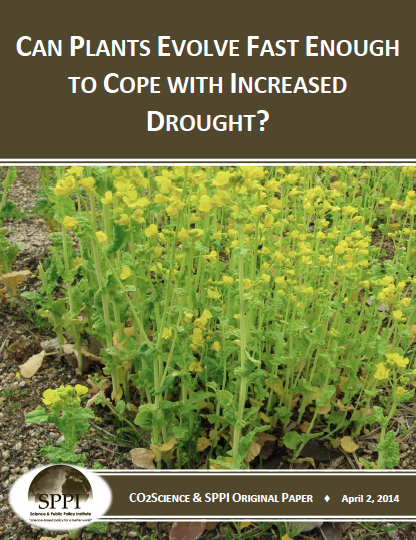News / Science & Technology
CAN PLANTS EVOLVE FAST ENOUGH TO COPE WITH INCREASED DROUGHT?

Evolution is generally thought of as acting over long periods of time. So is there anything it can do to help plants cope with the rapid climate changes that the IPCC predicts will be caused by the ongoing rise in the air's CO2 content? In what follows, this question is carefully considered as it applies to the daunting environmental challenge of droughts, which climate alarmists contend will become more intense and occur more frequently throughout many parts of the world in the years and decades to come.
Working with the field mustard (Brassica rapa) plant, Franks et al. (2007) compared "phenotypic and fitness values of ancestral, descendant, and ancestral x descendant hybrid genotypes grown simultaneously under conditions that mimicked those before and after a real-world switch from above-average to belowaverage precipitation in southern California (USA), which led to abbreviated growing seasons from 2000 to 2004. Fortuitously, as they described it, they had "collected B. rapa seed in 1997, before the drought, and then again in 2004 from two populations," a dry site and a wet site. Hence, they could grow - at the same time and under the same circumstances, in a new set of experiments - plants that had experienced extended drought conditions (descendants) and plants that had not experienced such conditions (ancestors), as well as hybrids of the two; and they could see if flowering times (FT) differed as would be expected from life history theory, which "predicts that the optimal FT in annual plants will be shorter with shorter growing seasons," such as those that were imposed by the extended drought that occurred between the two times of their seed collecting.
This work revealed, in the three researchers' words, that as predicted, "the abbreviated growing seasons caused by drought led to the evolution of earlier onset of flowering," such that plant descendants "bloomed earlier than ancestors, advancing first flowering by 1.9 days in one study population and 8.6 days in another." Moreover, they found that "the intermediate flowering time of ancestor x descendant hybrids supports an additive genetic basis for divergence." And in consequence of these several observations, they concluded that "natural selection for drought escape thus appears to have caused adaptive evolution in just a few generations," while further noting, in almost the same words, that "abundant evidence has accumulated over the past several decades showing that natural selection can cause evolutionary change in just a few generations (Kinnison and Hendry, 2001; Reznick and Ghalambor, 2001)."
